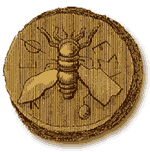
|
By 3500 B.C., bees were depicted as a royal symbol of the king (the Pharaoh). It seems to be associated with the "king " (actually queen) of the bee society. Relics prove beekeeping during this period was conducted in shrines during the 5th Dynasty (circa 2500 B.C.). Baskets woven of flexible hazel branches were used for beehives. There was also a cylindrical beehive made of clay. Honey was taken by driving bees away using smoke made by burning dried cow manure. Mobile beekeeping collecting honey by going up and down the Nile River by raft, was conducted 18th century.
|
|

|
Cylindrical beehives made of clay around the 10th century B.C. have been unearthed. Beekeeping techniques were initiated in Egypt, but no signs of technical progress are found during this period.
|
|

|
By the 1st century B.C., commercial beekeeping was established, and a large scale beehive control using slaves was conducted. Virgil described these techniques thoroughly in volume 4 of his "Poem of Agriculture."
|
|

|
Around the birth of Christ, there were beehives woven with small branches of willow trees.
|
|
|

|
Beehives made of logs or small branches from around the birth of Christ have been unearthed.
|
|
|
 |

|
Hollowed logs of date palms were used for beehives sometimes around the birth of Christ.
|
|
|
|

![]()


